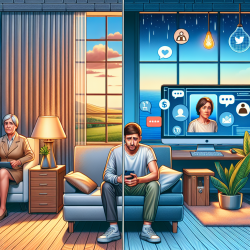As a practitioner, understanding the preferences and concerns of your patients is crucial for providing effective mental health care. A recent study titled Preference for in-person psychotherapy versus digital psychotherapy options for depression: survey of adults in the U.S provides valuable insights that can help improve your practice. This blog will explore the key findings and suggest ways to implement these outcomes to enhance your skills and encourage further research.
Key Findings
The study surveyed 164 adults in the U.S. who had previously considered or used psychotherapy for depression. The participants were asked about their preferences for four treatment modalities: self-guided digital, peer-supported digital, expert-guided digital, or in-person psychotherapy. The findings revealed that:
- 44.5% preferred in-person psychotherapy
- 25.6% preferred self-guided digital treatment
- 19.7% preferred expert-guided digital treatment
- 8.5% preferred peer-supported digital treatment
Several themes emerged from the qualitative analysis, including concerns about the efficacy of digital treatment, access barriers, confidentiality and privacy issues, and the impact of social anxiety on the use of video-chat based care.
Implementing the Findings
As a practitioner, you can use these insights to tailor your approach and improve patient outcomes:
Addressing Efficacy Concerns
Patients often question the effectiveness of digital therapy compared to in-person sessions. To address this, you can:
- Provide evidence-based information about the efficacy of digital treatments.
- Offer a hybrid model that combines in-person and digital sessions to gradually build patient confidence in digital therapy.
Improving Access
Access barriers such as cost, insurance limitations, and scheduling conflicts were significant concerns. To mitigate these barriers, consider:
- Offering flexible scheduling options for digital sessions.
- Working with insurance providers to ensure coverage for digital treatments.
- Providing cost-effective digital therapy options.
Enhancing Confidentiality and Privacy
Privacy concerns were more prevalent with digital therapy. To alleviate these concerns:
- Ensure robust data security measures are in place.
- Educate patients about the privacy safeguards in your digital therapy platforms.
Addressing Social Anxiety
Social anxiety can impact the effectiveness of both in-person and digital therapy. To help patients overcome this barrier:
- Offer initial sessions in a format that the patient is most comfortable with.
- Gradually introduce video-chat elements to build comfort and trust.
Encouraging Further Research
While this study provides valuable insights, more research is needed to fully understand patient preferences and improve digital therapy offerings. As a practitioner, you can contribute to this effort by:
- Participating in or conducting studies on digital therapy efficacy and patient preferences.
- Sharing your findings and experiences with the broader mental health community.
To read the original research paper, please follow this link: Preference for in-person psychotherapy versus digital psychotherapy options for depression: survey of adults in the U.S.










